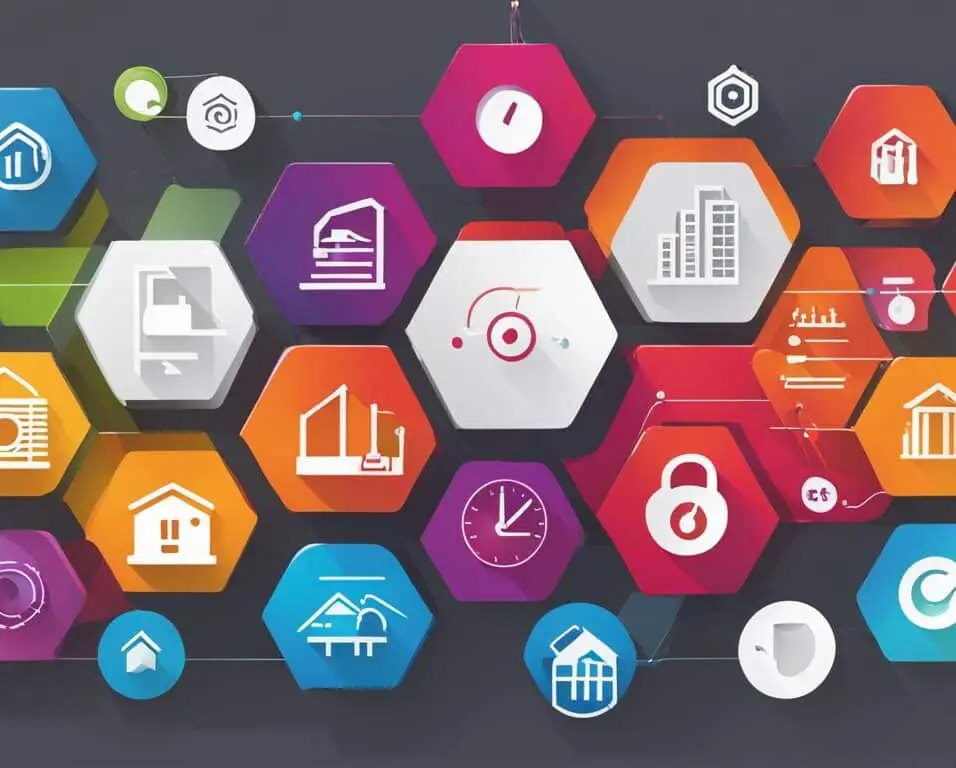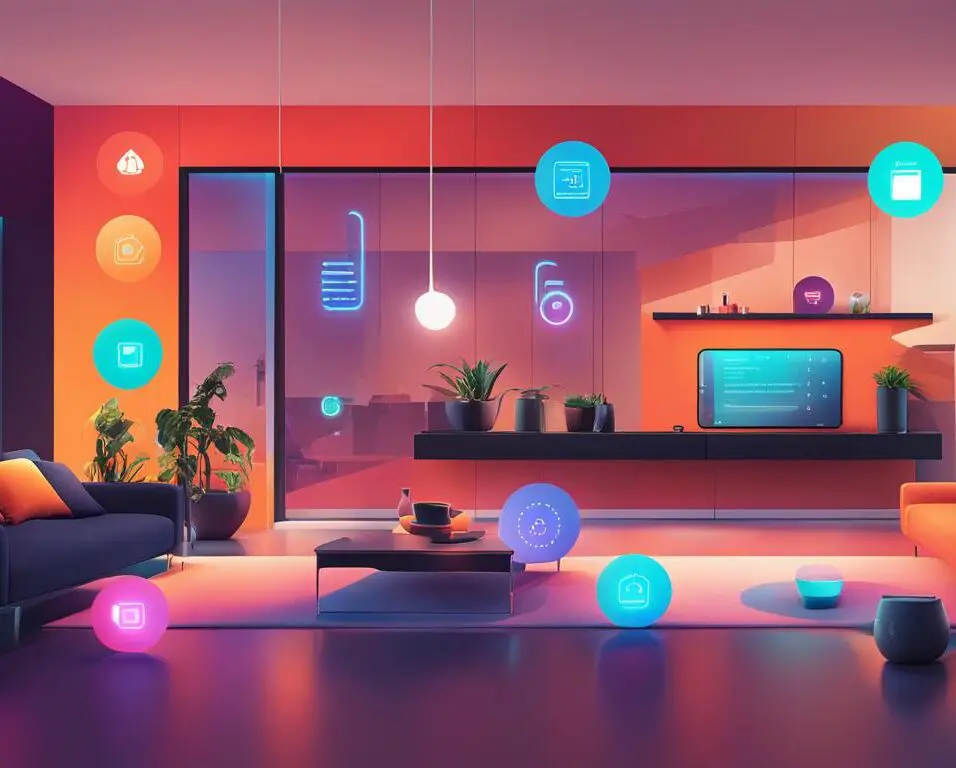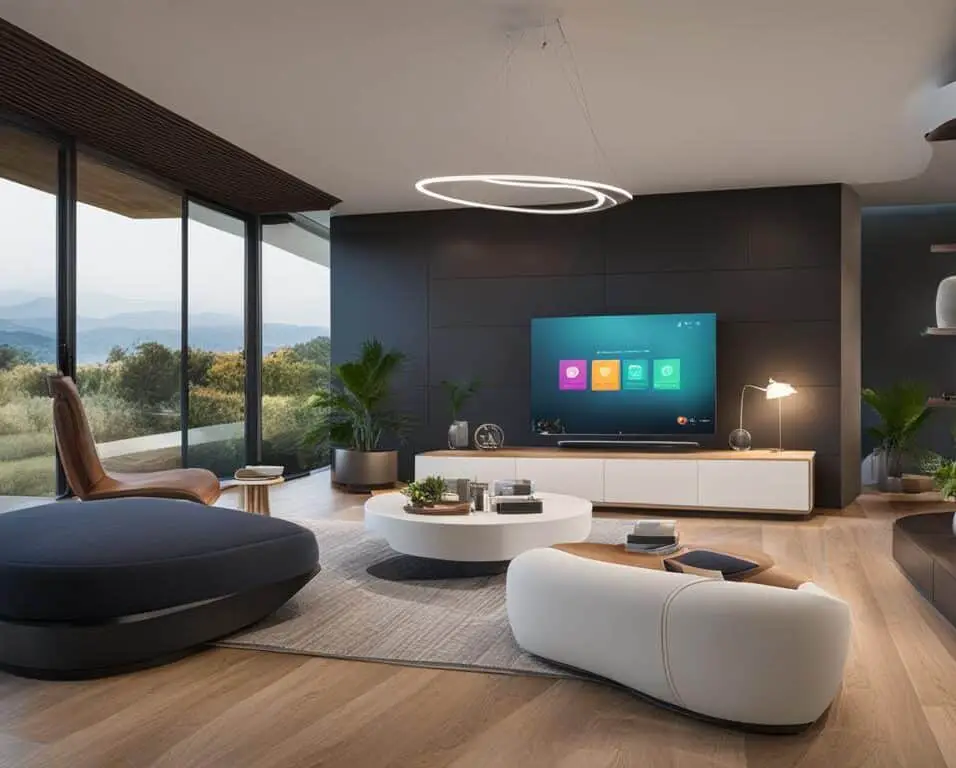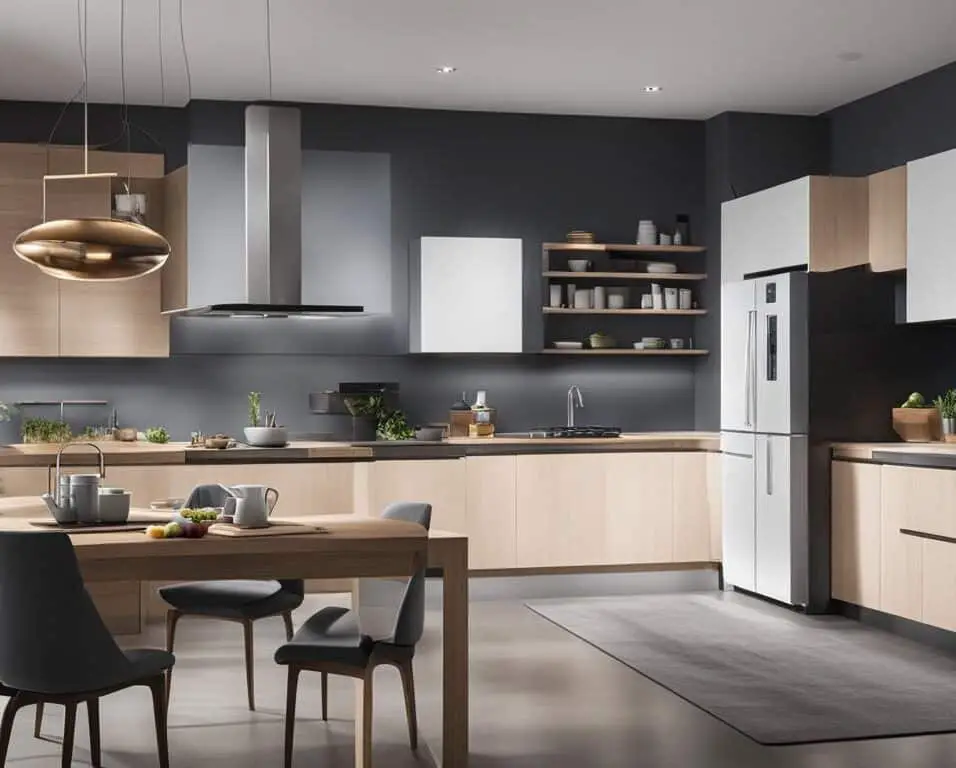IoT: Transforming Everyday Home Life
The Internet of Things (IoT) is revolutionizing the way we live and interact with our homes. By integrating IoT devices, we can create smart homes that offer enhanced convenience, energy efficiency, and security. Through the connection of everyday objects to the internet, IoT enables seamless communication and data exchange, providing us with intelligent and adaptive living environments.
Imagine a home where your appliances, lighting systems, and security devices are all connected, controlled, and monitored through your smartphone. With IoT, this is no longer a futuristic dream, but a reality. IoT devices collect data through embedded computer chips and sensors, which is then analyzed to take actions or provide feedback, making our lives more efficient and convenient.
Smart homes equipped with IoT devices can learn and adapt to personal preferences, adjusting temperature settings, lighting conditions, and even brewing your morning coffee remotely. Through the integration of artificial intelligence, smart homes offer personalized experiences and control at our fingertips, allowing customization based on mood or occasion.
In addition to convenience, IoT devices provide enhanced security and surveillance. Imagine being able to monitor your home through automated locks, smart garage door openers, and security cameras, all accessible through your smartphone. With IoT, the future of smart homes prioritizes security, energy efficiency, and personalized control.
Key Takeaways:
- The Internet of Things (IoT) is revolutionizing homes by integrating devices and enabling communication through the internet.
- IoT devices collect and exchange data, allowing for more efficient and convenient living experiences.
- Smart homes equipped with IoT devices offer personalized control, enhanced security, and energy efficiency.
- IoT is reshaping how we interact with our homes, making our lives more convenient, efficient, and secure.
- The future of smart homes will continue to prioritize security, energy efficiency, and personalized control through the integration of IoT and artificial intelligence.
The Exciting Potential of IoT in the Future
The future of IoT holds even more potential to transform our world. As technology continues to advance, IoT is set to revolutionize various aspects of our lives. Futuristic examples include smart cities with IoT-enabled traffic lights, IoT-enhanced healthcare with wearable devices predicting health issues, and the rise of self-driving cars and delivery drones.
“The future of IoT is incredibly promising, with the potential to create connected environments that improve efficiency, convenience, and quality of life,” says Dr. Mary Johnson, a leading expert in IoT technology.
Retail experiences will also be revolutionized by IoT, allowing personalized, automated shopping experiences. Innovations like precision agriculture, IoT in education, energy efficiency, healthcare on the go, and blockchain integration are driving the future of IoT.
Projected Scale of IoT Growth
News articles and reports highlight the projected scale of IoT growth, with 50 billion devices predicted by 2030. This exponential growth demonstrates the increasing influence of IoT in our lives and suggests a future where interconnected devices will become the norm.
Connecting Tomorrow
The future of IoT is rapidly unfolding, setting the stage for a connected tomorrow. With IoT technology, we can expect seamless integration of devices and environments, creating a more efficient and convenient world.
| Industry | Impact of IoT |
|---|---|
| Smart Cities | Efficient traffic management, improved energy consumption, enhanced public safety |
| Healthcare | Remote patient monitoring, early disease detection, personalized treatment |
| Retail | Automated shopping experiences, personalized marketing strategies |
| Transportation | Self-driving cars, optimized routes, reduced traffic congestion |
| Agriculture | Precision farming, improved crop yield and resource management |
| Education | Enhanced learning experiences through interactive and personalized education |
| Energy | Improved energy efficiency, smart grid management |
The Importance of Integrating IoT Devices for Smart Homes
Integrating IoT devices is crucial for creating efficient smart homes. By connecting everyday objects like appliances, lighting systems, security systems, and even shower controls to the internet, homeowners can experience increased energy efficiency and convenience. Smart homes can learn and adapt to personal preferences, adjusting temperature settings, lighting, and even coffee brewing remotely through smartphone apps. AI integration enables personalized experiences and control at our fingertips, allowing customization based on mood or occasion.
Additionally, IoT devices provide enhanced security and surveillance through automated locks, smart garage door openers, and security cameras. Homeowners can monitor their premises from anywhere in the world and receive instant notifications in case of any unusual activity. With IoT-enabled security systems, the future of smart homes will continue to prioritize security, energy efficiency, and personalized control.
The Benefits of Integrating IoT Devices in Smart Homes:
- Increased energy efficiency by optimizing appliance usage and controlling lighting systems
- Convenience through remote control of various home functions via smartphone apps
- Personalized experiences based on individual preferences and moods
- Enhanced security and surveillance through IoT-enabled locks, garage door openers, and security cameras
Integrating IoT devices in smart homes not only brings comfort, convenience, and security, but also paves the way for a more sustainable and connected living environment.
By seamlessly integrating IoT devices, homeowners can transform their houses into intelligent and adaptable living spaces. With the ability to control and monitor various aspects of their homes remotely, it’s easier than ever to create a personalized and efficient living experience. The future of smart homes holds immense potential, with advancements in technology further enhancing the possibilities for creating smarter, more connected living spaces.
| Benefits of Integrating IoT Devices in Smart Homes | Examples |
|---|---|
| Increased energy efficiency | Smart thermostats regulating temperature based on occupancy and weather conditions |
| Convenience | Remotely controlling home appliances and lighting systems through smartphone apps |
| Personalized experiences | Adjusting lighting, temperature, and music based on individual preferences and moods |
| Enhanced security and surveillance | Automated locks, garage door openers, and security cameras with remote monitoring capabilities |
Integrating IoT devices in smart homes not only brings comfort, convenience, and security, but also paves the way for a more sustainable and connected living environment. With the constant advancements in IoT technology, the possibilities for creating smarter, more intuitive homes are endless.
Transforming Transportation with IoT
The transportation industry is undergoing a revolutionary transformation with the integration of IoT technology. One of the most significant advancements in this field is the development of self-driving cars. Companies like Tesla are leading the way by producing autonomous vehicles that utilize AI and IoT technology to provide safer and more efficient transportation options.
With the introduction of 5G wireless technology, the capabilities of these self-driving cars will be further enhanced. Data collection and sharing will be faster and more efficient, leading to near-zero accidents and improved commuting experiences for passengers.
In addition to self-driving cars, IoT is also making public transportation systems more connected and efficient. IoT-connected public transportation systems can optimize routes, provide accurate arrival times to riders, and reduce delays through predictive maintenance. This leads to a more reliable and convenient experience for commuters, while also reducing traffic congestion.
Benefits of IoT in Transportation
The integration of IoT in transportation offers several key benefits:
- Improved Safety: Self-driving cars equipped with IoT technology can analyze data from various sensors to make decisions in real-time, resulting in safer road conditions and reduced accidents.
- Enhanced Efficiency: IoT enables optimal route planning and coordination between different modes of transportation, minimizing travel times and maximizing fuel efficiency.
- Predictive Maintenance: IoT sensors can monitor the condition of vehicles and transportation infrastructure, allowing for proactive maintenance and reducing breakdowns and delays.
- Smart Traffic Management: IoT-powered traffic management systems can optimize traffic flow, reduce congestion, and improve overall transportation efficiency.
By harnessing the power of IoT, the transportation industry is experiencing a transformative shift towards a more connected and sustainable future.
In the words of Elon Musk, the CEO of Tesla: “The future of transportation is autonomous. And the future of autonomy is IoT.”

Future Possibilities
The potential of IoT in transportation is immense. As technology continues to advance, we can expect further innovations and improvements in the following areas:
| IoT in Transportation | Potential Advancements |
|---|---|
| Connected Vehicles | Real-time communication between vehicles to enhance safety and coordination on the road. |
| Smart Infrastructure | IoT-enabled traffic lights, smart roadways, and intelligent transportation systems to optimize traffic flow. |
| Smart Logistics | Efficient tracking and management of goods through IoT-enabled supply chain systems. |
| Shared Mobility | IoT-powered ride-sharing platforms and smart parking solutions to improve efficiency and reduce congestion. |
The future of transportation is destined to be transformed by IoT, bringing us closer to a world of seamless connectivity, enhanced safety, and more efficient mobility.
IoT’s Impact on Healthcare
The integration of IoT in the healthcare industry has the potential to revolutionize patient care and enhance communication between doctors and patients. One of the key areas where IoT is already making a significant impact is in wearable devices, such as fitness trackers and smartwatches. These devices collect health metrics in real-time, providing valuable data to healthcare professionals.
With IoT integration, wearable devices go beyond simple data collection and become powerful tools for continuous monitoring and personalized healthcare interventions. They can transmit data directly to physicians, enabling them to track patients’ health conditions remotely and intervene proactively. This constant flow of real-time data allows healthcare providers to make informed decisions and tailor treatment plans to individual needs.
IoT devices also play a crucial role in improving patient adherence to treatment plans. By sending reminders and tracking medication usage, these devices help patients stay on track with their prescribed therapies. This level of monitoring can greatly contribute to better patient outcomes and reduced healthcare costs.
In addition to monitoring and adherence, IoT facilitates remote consultations through telemedicine. Patients can connect with healthcare professionals from the comfort of their homes, eliminating the need for unnecessary hospital visits and reducing the burden on healthcare facilities. This is particularly beneficial for individuals living in remote areas or those with limited mobility.
IoT in healthcare has the potential to improve patient outcomes, personalize treatments, and provide more efficient healthcare delivery.
The combination of IoT and healthcare holds great promise for the future. As technology continues to advance and IoT devices become more sophisticated, the healthcare industry will undoubtedly witness further advancements in the way patient care is delivered. From remote monitoring to personalized treatments and remote consultations, IoT is transforming healthcare, making it more patient-centric and accessible.
Benefits of IoT in Healthcare:
- Real-time monitoring of health metrics
- Continuous tracking of patient conditions
- Personalized healthcare interventions
- Improved patient adherence to treatment plans
- Remote consultations through telemedicine
As we embrace the potential of IoT in healthcare, it is imperative to prioritize data security and patient privacy. Robust measures must be in place to ensure that sensitive health information remains confidential and protected from cyber threats.
With IoT’s transformative impact on healthcare, we are entering an era of connected and patient-centric healthcare delivery. The future holds immense potential to leverage IoT technology and wearable devices to further enhance patient outcomes, improve healthcare access, and revolutionize the way we receive medical care.
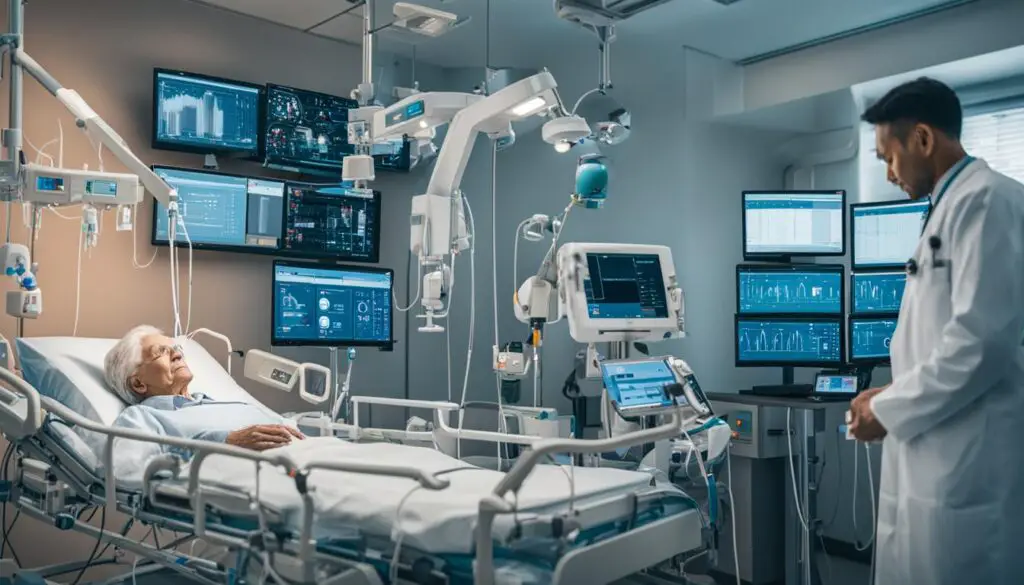
Conclusion
The integration of Smart Home Automation and the concept of IoT is revolutionizing everyday living experiences. From streamlined kitchen automation to enhanced security and surveillance, control at our fingertips, energy efficiency, robotic control, and smart restrooms, IoT is transforming our homes into intelligent, adaptive environments.
AI and IoT integration enable personalized experiences and cohesive smart home environments. By seamlessly connecting devices and enabling them to communicate with each other, IoT creates a connected ecosystem that simplifies and automates various aspects of our lives.
The future of IoT holds immense potential to continue reshaping our world in countless ways. Smart homes, transportation systems, healthcare facilities, and various industries will all benefit from this technology. As we drive towards innovation, IoT will play a pivotal role in creating comfortable, convenient, and sustainable living spaces for the future.
FAQ
What is IoT?
IoT stands for the Internet of Things, where physical objects are connected to the internet, allowing them to collect and exchange data.
How does IoT work?
IoT works through tiny computer chips and sensors embedded within objects, which collect data and connect to the internet. The data collected is then analyzed and used to take actions or provide feedback.
What are some examples of IoT in everyday life?
IoT has made its mark in various aspects of everyday life, including smart homes, healthcare, agriculture, transportation, and cities. Examples include smart fridges, wearable devices, self-driving cars, and IoT-enabled traffic lights.
What is the future potential of IoT?
The future of IoT holds even more potential to transform our world. This includes innovations like smart cities, IoT-enhanced healthcare, self-driving cars, personalized shopping experiences, precision agriculture, and more.
How does IoT benefit smart homes?
Integrating IoT devices in smart homes enables increased energy efficiency, convenience, personalized control, enhanced security, and surveillance.
How is IoT revolutionizing transportation?
IoT is enabling the development of self-driving cars, improved public transportation systems, optimized routes, accurate arrival times, and reduced traffic congestion.
What is the impact of IoT on healthcare?
IoT improves patient outcomes and communication between doctors and patients through wearable devices that capture health metrics in real-time, continuous monitoring, personalized interventions, remote consultations, and better healthcare delivery.
How is IoT transforming everyday living experiences?
IoT revolutionizes everyday living experiences through smart home automation, streamlined kitchen automation, energy efficiency, enhanced security and surveillance, robotic control, smart restrooms, and cohesive smart home environments.
Source Links
- https://www.conurets.com/the-future-of-home-automation-how-iot-is-transforming-everyday-living/
- https://medium.com/@guestposts_92864/how-the-internet-of-things-will-transform-daily-life-e44be96f7c18
- https://medium.com/@kiran.m.narayana/the-internet-of-things-iot-transforming-everyday-life-a261f663b325




